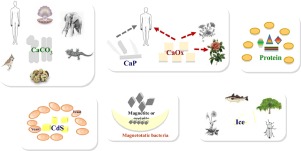Synthesis of inorganic and organic crystals mediated by proteins in different biological organisms. A mechanism of biomineralization conserved throughout evolution in all living species
Mayra Cuéllar-Cruz
文献索引:10.1016/j.pcrysgrow.2017.07.001
全文:HTML全文
摘要

The synthesis of crystals through biomineralization is a process of protection and support preserved in animals, protists, moneras, plants and fungi. The genome of every species has evolved to preserve and/or modify the formation of one or another type of crystal, which may be of the organic or inorganic type. The most common inorganic crystals identified in organisms include calcium carbonate (CaCO3), calcium phosphate (CaP), calcium oxalate (CaOx), magnetite or greigite, and sulfides of cadmium (CdS), mercury (HgS) and lead (PbS). Organic crystals are of the protein or ice type. The formation of both types of crystals requires biomolecules such as proteins. This paper reviews the proteins involved in the synthesis of different crystals in distinct biological systems, in order to understand how each organism has adapted its genome to preserve essential mechanisms such as biomineralization, which has enabled them to survive in a changing environment for millions of years.
|
Synthesis and characterization of electrical features of bis...
2018-03-17 [10.1016/j.pcrysgrow.2018.02.001] |
|
Epitaxial growth of highly mismatched III-V materials on (00...
2017-11-14 [10.1016/j.pcrysgrow.2017.10.001] |
|
Lifting the mist of flatland: The recent progress in the cha...
2017-06-20 [10.1016/j.pcrysgrow.2017.06.001] |
|
Germanium based photonic components toward a full silicon/ge...
2017-05-20 [10.1016/j.pcrysgrow.2017.04.004] |
|
Molecular beam epitaxy as a growth technique for achieving f...
2017-04-25 [10.1016/j.pcrysgrow.2017.04.001] |